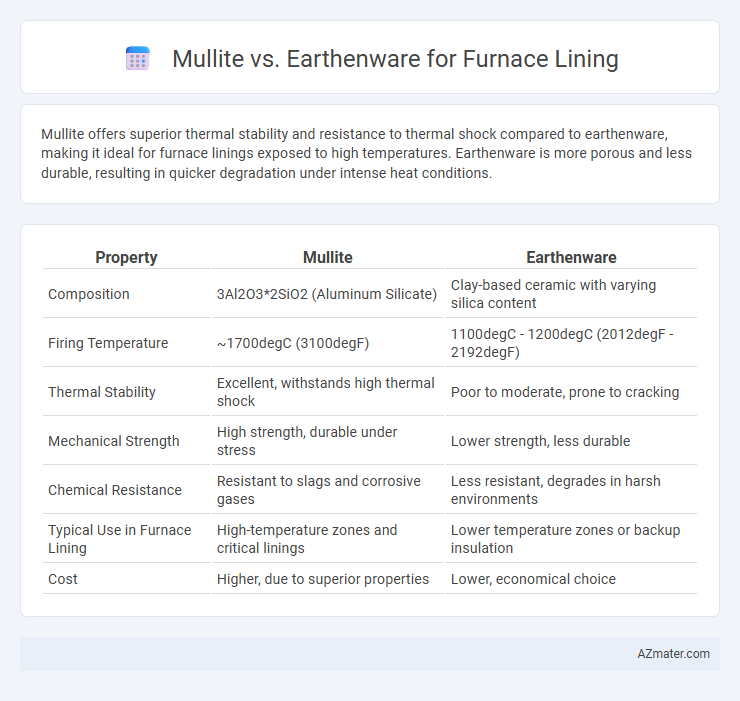Mullite offers superior thermal stability and resistance to thermal shock compared to earthenware, making it ideal for furnace linings exposed to high temperatures. Earthenware is more porous and less durable, resulting in quicker degradation under intense heat conditions.
Table of Comparison
| Property | Mullite | Earthenware |
|---|---|---|
| Composition | 3Al2O3*2SiO2 (Aluminum Silicate) | Clay-based ceramic with varying silica content |
| Firing Temperature | ~1700degC (3100degF) | 1100degC - 1200degC (2012degF - 2192degF) |
| Thermal Stability | Excellent, withstands high thermal shock | Poor to moderate, prone to cracking |
| Mechanical Strength | High strength, durable under stress | Lower strength, less durable |
| Chemical Resistance | Resistant to slags and corrosive gases | Less resistant, degrades in harsh environments |
| Typical Use in Furnace Lining | High-temperature zones and critical linings | Lower temperature zones or backup insulation |
| Cost | Higher, due to superior properties | Lower, economical choice |
Introduction to Furnace Lining Materials
Mullite and earthenware are key materials used in furnace lining, with Mullite valued for its high-temperature stability and resistance to thermal shock, making it ideal for industrial kilns operating above 1500degC. Earthenware, composed primarily of clay, offers good insulating properties but lower durability and temperature resistance, typically suitable for lower temperature applications up to 1200degC. The choice between Mullite and earthenware depends on the specific thermal and mechanical demands of the furnace environment.
Properties of Mullite in High-Temperature Applications
Mullite exhibits exceptional thermal stability and resistance to thermal shock, making it ideal for furnace linings exposed to temperatures above 1600degC. Its low thermal conductivity and excellent mechanical strength at high temperatures ensure durability and energy efficiency in harsh industrial environments. Compared to earthenware, mullite's superior resistance to chemical corrosion and creep deformation significantly enhances furnace longevity and performance.
Key Characteristics of Earthenware as Lining Material
Earthenware, known for its porous structure and relatively low firing temperature, offers moderate thermal insulation but limited chemical resistance compared to Mullite. Its lower density results in higher thermal expansion, making it less stable under rapid temperature changes typical in furnace environments. Despite these limitations, earthenware is cost-effective and sufficiently durable for low-temperature applications where mechanical stresses are minimal.
Thermal Stability: Mullite vs Earthenware
Mullite offers superior thermal stability compared to earthenware, maintaining structural integrity at temperatures exceeding 1,600degC, making it ideal for high-temperature furnace linings. Earthenware typically withstands temperatures up to around 1,000degC but experiences significant degradation and thermal shock beyond this range. The enhanced thermal shock resistance and low thermal expansion coefficient of mullite ensure longer service life and reduced maintenance in industrial furnace applications.
Mechanical Strength Comparison
Mullite offers significantly higher mechanical strength compared to earthenware, making it more resistant to thermal shock and mechanical stress in furnace linings. Its superior tensile strength and fracture toughness enable prolonged durability under extreme temperatures, unlike earthenware, which is more brittle and prone to cracking. The enhanced structural integrity of mullite reduces maintenance frequency and improves furnace lifespan in high-temperature industrial applications.
Resistance to Corrosion and Chemical Attack
Mullite exhibits superior resistance to corrosion and chemical attack compared to earthenware, making it more suitable for furnace linings exposed to aggressive environments. Its stable alumino-silicate structure withstands alkalis, slags, and acidic gases without significant degradation. Earthenware, primarily composed of porous clay, is more prone to chemical erosion and reduced durability in corrosive furnace atmospheres.
Cost Analysis and Economic Considerations
Mullite offers superior thermal stability and longer service life compared to earthenware, justifying its higher initial cost in furnace lining applications. Earthenware provides a lower upfront investment but may lead to increased maintenance expenses and more frequent replacements due to its lower thermal resistance. Evaluating total lifecycle costs, including durability and thermal efficiency, reveals mullite as the more cost-effective option in high-temperature industrial environments.
Installation and Maintenance Requirements
Mullite furnace linings demand precise installation techniques, including proper drying and firing cycles, to ensure high thermal shock resistance and longevity. Earthenware linings offer easier installation with lower initial costs but require frequent maintenance due to lower durability and susceptibility to cracking under high temperatures. Regular inspection and timely repair are critical for earthenware to prevent failure, while mullite's robust structure minimizes maintenance frequency, enhancing furnace efficiency and lifespan.
Longevity and Performance in Industrial Furnaces
Mullite offers superior longevity and thermal shock resistance compared to earthenware, making it ideal for industrial furnace linings exposed to extreme temperatures. Its high alumina content enhances structural integrity and performance under rapid temperature fluctuations, reducing maintenance frequency and downtime. Earthenware, while cost-effective, lacks the durability and heat resistance necessary for long-term use in demanding furnace environments, leading to quicker wear and reduced operational efficiency.
Choosing the Right Material: Mullite or Earthenware?
Mullite offers superior thermal stability and higher resistance to thermal shock compared to earthenware, making it ideal for furnace linings exposed to extreme temperatures. Earthenware, while more cost-effective, has lower mechanical strength and limited heat resistance, which can lead to quicker degradation under intense heat. Choosing mullite enhances furnace longevity and efficiency, especially in industrial applications requiring sustained high-temperature performance.

Infographic: Mullite vs Earthenware for Furnace Lining
 azmater.com
azmater.com